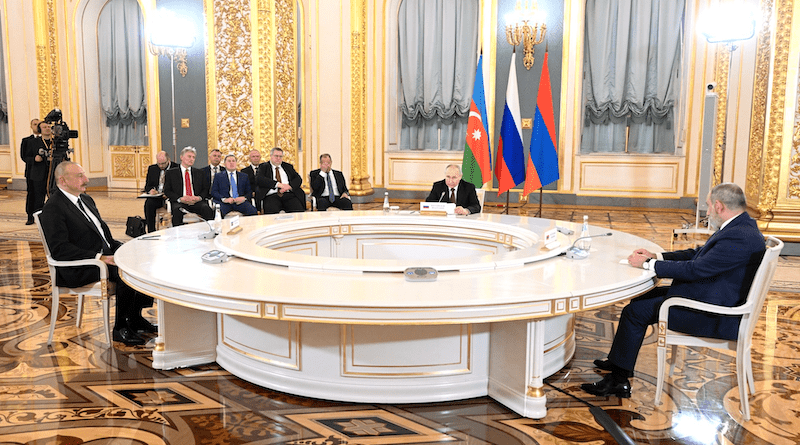Azerbaijani President Doubles Down On Demand For Ex-Soviet Exclaves’ Return
By Eurasianet
(Eurasianet) — Azerbaijan’s president doubled down on his country’s right to sovereignty over a handful of territories that belonged to Soviet Azerbaijani but have been under Armenian control for more than 30 years.
In his first interview in 2024 to local TV stations, President Ilham Aliyev touched on the February 7 snap presidential election, his government’s performance in 2023, the military seizure of Nagorno-Karabakh, and prospects for a peace deal with Armenia.
One question posed to him was about the fate of ex-Soviet-Azerbaijani exclaves and villages now under Armenian control in light of the border delimitation work between the countries.
The villages at issue here are distant from and far smaller than the main territory that has been under contention for three decades – Nagorno-Karabakh. Now that Azerbaijan has restored full sovereignty over Karabakh, more focus is on the villages, and their status is also in play as the two sides prepare to negotiate over a formal border and a final resolution to the conflict.
There are seven such villages in northwestern Gazakh district. Four of the seven villages – Baghanis Ayrim, Lower Askipara, Kheyrimli, and Gizilhajili – were on the Azerbaijani side of the border between the two former Soviet republics, and were occupied by Armenian forces in the 1990s. Upper Askipara, along with two more villages – Sofulu and Barkhudarli – are oddities of Soviet border-drawing: village-sized exclaves of one former Soviet Socialist Republic inside the borders of another (more than 4,100 Azerbaijanis fled those villages).
Another Azerbaijani exclave, Karki, is further to the south, near Nakhchivan. And there is one Armenian exclave, Artsvashen, inside Azerbaijan; in the 1990s its Armenian residents faced a similar fate to those on the other side of the border.
“The villages that are not enclaves, the four villages should be returned to Azerbaijan without any preconditions,” Aliyev stated. “For the villages that are enclaves, a separate expert group should be established and this issue should be discussed. We believe that all enclaves should be returned. The roads leading to these enclaves should have the necessary conditions and the people living there should be accommodated in these enclaves. So, this is our position. We cannot understand Armenia’s position.”
There have been rumors ever since the end of the 2020 war between Armenia and Azerbaijan, that the villages would return to Azerbaijani control. Soon after the end of the war, the following day Recep Tayyip Erdogan, the president of Azerbaijan’s closest ally Turkey, referred to “the return of the Gazakh villages” in a speech to parliament. In June last year, Armenian Prime Minister Nikol Pashinyan’s comment at a Q&A session gave the impression that his government was willing to give up Karki.
Most recently, in October, Azerbaijani media speculated that Pashinyan had pledged to return the villages to Azerbaijan, citing the statement he signed with the leaders of the EU, Germany, and France, in which he recognized Azerbaijan’s territorial integrity.
Also in October, Aliyev told European Council President Charles Michel by phone on October 7 that eight villages of Azerbaijan were “still under Armenian occupation, and stressed the importance of liberating these villages from occupation.”
While the issue is still debated, Armenian and Azerbaijani border delimitation commissions keep meeting on the border, without mediators’ support. Aliyev said in his interview that the next meeting of the commissions will be held this month, and the issue of the Gazakh villages is on the agenda.
Another issue at the heart of the border talks is the presence of Azerbaijani troops deep inside what’s generally regarded as Armenian territory. Azerbaijan made several incursions into Armenia since the 2020 war and currently holds an estimated 215 square kilometers of its land.
Aliyev said in the interview that his army would not be retracting any time soon. “Neither from the positions of May 2021 nor from the positions of September 2022. We are not taking a step back because that border must be defined. However, our location, which is currently disputed by Armenia, does not include any settlement. The positions and heights where we stand have never been inhabited before. Today, Armenia continues to occupy our villages, and this is unacceptable. I want to note again that this issue will be clarified during the meeting of the commissions at the end of this month.”

